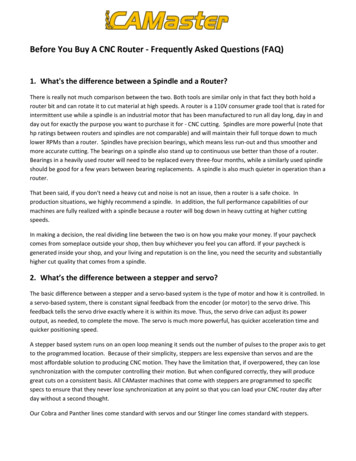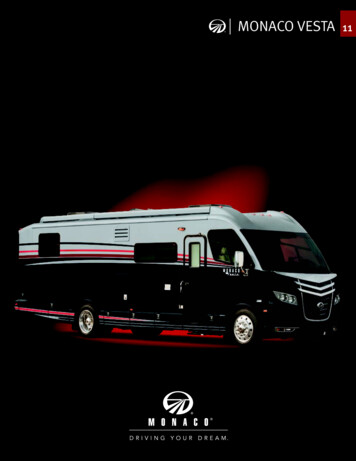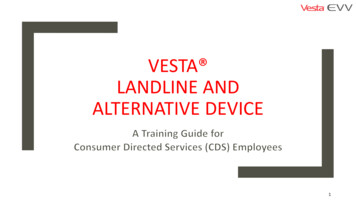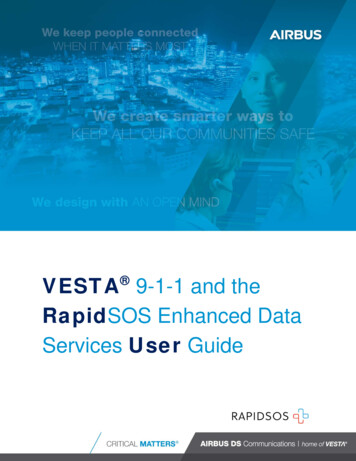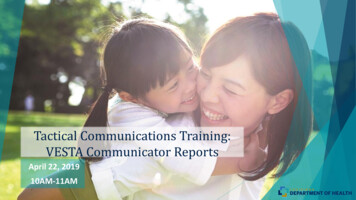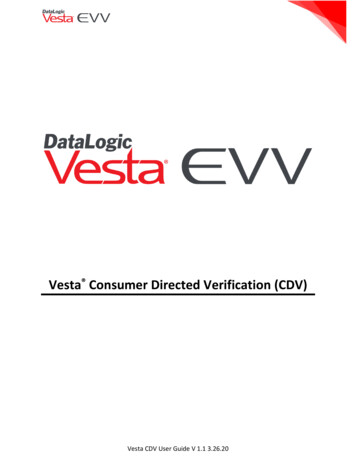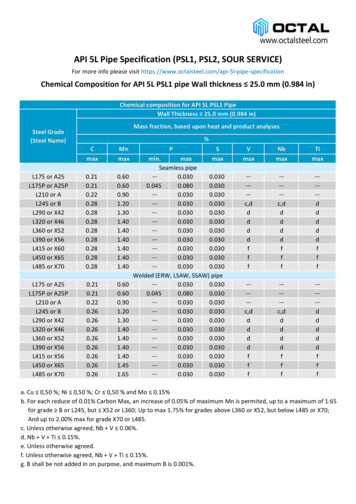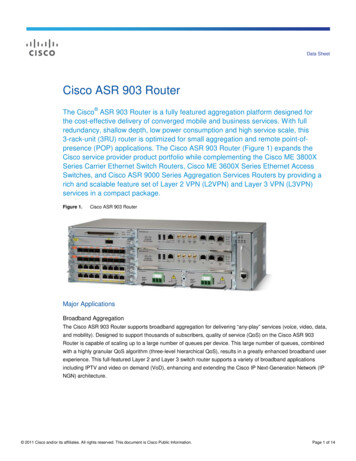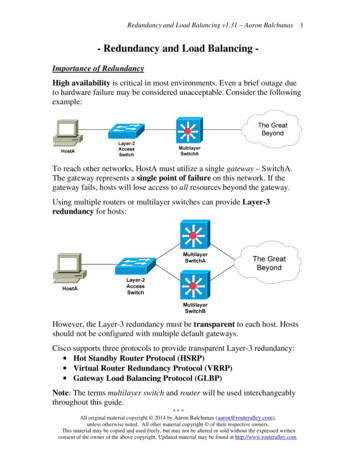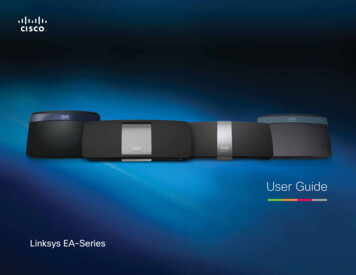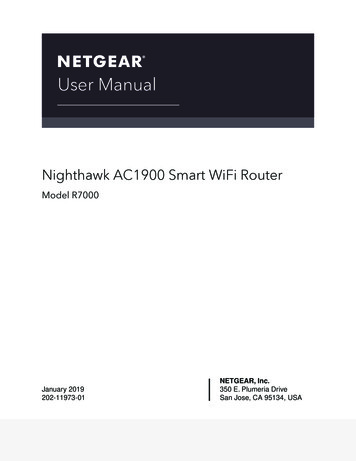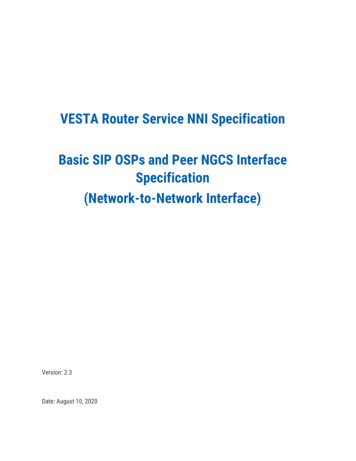
Transcription
VESTA Router Service NNI SpecificationBasic SIP OSPs and Peer NGCS InterfaceSpecification(Network-to-Network Interface)Version: 2.3Date: August 10, 2020
TABLE OF CONTENTSTABLE OF CONTENTS2DOCUMENT HISTORY4EXECUTIVE SUMMARY5NOTESARCHITECTURE OVERVIEW56INTERCONNECTION MODEL AND CALL CAPACITY6DIAGRAM7DEMARCATION POINTS7CONNECTION REQUIREMENTS8NETWORK PROTOCOLS8PHYSICAL CONNECTIVITY8NETWORK REDUNDANCY8TRANSPORT DESIGN9IP ROUTING DESIGN10ADDRESSING10MTU10QoS REQUIREMENTS11GENERAL11PACKET LOSS11JITTER11LATENCY11SECURITY12DNS13 2020 Vesta Solutions, Inc., a wholly owned subsidiary of Motorola Solutions, Inc. This document is protected by copyright law and international treaties, and is the CONFIDENTIAL AND PROPRIETARY information ofVesta Solutions, Inc. All trademarks, service marks, product names, brands, company names and logos appearing in this document are the property of their respective owners. VESTA is a registered trademark of VestaSolutions, Inc. 2020, Motorola Solutions. All rights reserved. MOTOROLA, MOTO, MOTOROLA SOLUTIONS, and the Stylized M Logo are trademarks or registered trademarks of Motorola Trademark Holdings, LLC and are used underlicense. All other trademarks are the property of their respective owners.2
MEDIA INTERFACESPECIFICATIONSSIP INTERFACE STANDARD FOR EMERGENCY CALL ACCEPTANCE141415NEW CALL RECEIVED15PEER NGCS NETWORKS (Applicable to calls being transferred)15ASSUMPTIONS16SIP HEADER REQUIREMENTS17SIP HeadersEXAMPLESINVITE for a basic SIP Call Example182121REFERENCE DOCUMENTS22ACRONYMS23APPENDIX25APPENDIX 1 : RFC DESCRIPTIONS25 2020 Vesta Solutions, Inc., a wholly owned subsidiary of Motorola Solutions, Inc. This documentis protected by copyright law and international treaties, and is the CONFIDENTIAL ANDPROPRIETARY information of Vesta Solutions, Inc. All trademarks, service marks, product names,brands, company names and logos appearing in this document are the property of their respectiveowners. VESTA is a registered trademark of Vesta Solutions, Inc.2 2020, Motorola Solutions. All rights reserved. MOTOROLA, MOTO, MOTOROLA SOLUTIONS, andthe Stylized M Logo are trademarks or registered trademarks of Motorola Trademark Holdings, LLCand are used under license. All other trademarks are the property of their respective owners.2 2020 Vesta Solutions, Inc., a wholly owned subsidiary of Motorola Solutions, Inc. This document is protected by copyright law and international treaties, and is the CONFIDENTIAL AND PROPRIETARY information ofVesta Solutions, Inc. All trademarks, service marks, product names, brands, company names and logos appearing in this document are the property of their respective owners. VESTA is a registered trademark of VestaSolutions, Inc. 2020, Motorola Solutions. All rights reserved. MOTOROLA, MOTO, MOTOROLA SOLUTIONS, and the Stylized M Logo are trademarks or registered trademarks of Motorola Trademark Holdings, LLC and are used underlicense. All other trademarks are the property of their respective owners.3
DOCUMENT HISTORYAuthorDateVersionDescriptionSteve MardakisJuly 08, 20201.0Initial version.Steve MardakisJuly 20, 20202.0Adapted to be specificto Basic SIP.Steve MardakisAugust 04, 20202.1Corrections followingreview.Steve MardakisAugust 07, 20202.2Corrections followingreview.Steve MardakisAugust 10, 20202.3DRI clarifications. 2020 Vesta Solutions, Inc., a wholly owned subsidiary of Motorola Solutions, Inc. This document is protected by copyright law and international treaties, and is the CONFIDENTIAL AND PROPRIETARY information ofVesta Solutions, Inc. All trademarks, service marks, product names, brands, company names and logos appearing in this document are the property of their respective owners. VESTA is a registered trademark of VestaSolutions, Inc. 2020, Motorola Solutions. All rights reserved. MOTOROLA, MOTO, MOTOROLA SOLUTIONS, and the Stylized M Logo are trademarks or registered trademarks of Motorola Trademark Holdings, LLC and are used underlicense. All other trademarks are the property of their respective owners.4
EXECUTIVE SUMMARYThis document establishes interface specifications for Originating Service Providers (OSPs) and otherNG9-1-1 Service Providers interconnecting to the VESTA Router Service for calls handoff and/or callstransfer using basic SIP.The intention of this document is to provide the interface specification for NG9-1-1 partners, OSPs orother 9-1-1 Service Providers. It is not intended to provide a detailed overview of the functionality ofNG9-1-1 or to cover details already specified in existing normative references (e.g., NENA or ATISstandards). Reference to such specifications are made throughout the document, however, unless analternative has been identified, the NENA i3 standard should be viewed as the default standard.The scope of this document is to provide a specification of SIP and RTP protocols that providesequivalency to a 9-1-1 Selective Router to 9-1-1 Selective Router SS7 interface and an OSP deliveringcalls to a 9-1-1 Selective Router.Basic SIP replaces legacy TDM facilities with the benefits of IP, eliminating point to point TDM trunksand gaining the benefits of IP transport technologies. Basic SIP does not present caller’s location withthe SIP messaging, although a hybrid version could do so before the entities implement a full i3functional interface between OSP and 9-1-1 Service Provider.Throughout the document, the reference to OSP is used in a generic way to encompass true OriginatingService Providers as well as, depending on the context, peer networks ingressing or transferring calls tothe VESTA Router Service.NOTESDetailed specifications around DNS support and IPv6 support are the objective guidelines. Currently it isunderstood that not all cases and deployments are fully compliant. 2020 Vesta Solutions, Inc., a wholly owned subsidiary of Motorola Solutions, Inc. This document is protected by copyright law and international treaties, and is the CONFIDENTIAL AND PROPRIETARY information ofVesta Solutions, Inc. All trademarks, service marks, product names, brands, company names and logos appearing in this document are the property of their respective owners. VESTA is a registered trademark of VestaSolutions, Inc. 2020, Motorola Solutions. All rights reserved. MOTOROLA, MOTO, MOTOROLA SOLUTIONS, and the Stylized M Logo are trademarks or registered trademarks of Motorola Trademark Holdings, LLC and are used underlicense. All other trademarks are the property of their respective owners.5
ARCHITECTURE OVERVIEWINTERCONNECTION MODEL AND CALL CAPACITYInterconnection between the Peering Network (OSP, Aggregator or other ESInet) and an instance ofVESTA Router Service is a redundant interconnection model as illustrated in the following diagram.Capacity, or number of simultaneous calls, between the Peering Network and the VESTA Router Serviceinstance is determined by mutual agreement. There is currently no programmatic method to enforce acall volume limit (other than the receiving entity responding with a SIP messaging to reject calls abovesome threshold) and it is expected each entity will cooperatively use the facilities per agreements.Denial of Service (DOS) attacks or similar network scenarios will be handled according to the entitiesnetwork management functions. 2020 Vesta Solutions, Inc., a wholly owned subsidiary of Motorola Solutions, Inc. This document is protected by copyright law and international treaties, and is the CONFIDENTIAL AND PROPRIETARY information ofVesta Solutions, Inc. All trademarks, service marks, product names, brands, company names and logos appearing in this document are the property of their respective owners. VESTA is a registered trademark of VestaSolutions, Inc. 2020, Motorola Solutions. All rights reserved. MOTOROLA, MOTO, MOTOROLA SOLUTIONS, and the Stylized M Logo are trademarks or registered trademarks of Motorola Trademark Holdings, LLC and are used underlicense. All other trademarks are the property of their respective owners.6
DIAGRAMThis diagram is showing the different types of calls that can be received and handled by the VESTARouter service as they were described in the previous section.DEMARCATION POINTSFor the scope of this document, the pertinent demarcation points are the borders between the VESTARouter Service domain and the Citizen/OSP, Selective Router and Peer NGCS domains as represented inthe diagram above. 2020 Vesta Solutions, Inc., a wholly owned subsidiary of Motorola Solutions, Inc. This document is protected by copyright law and international treaties, and is the CONFIDENTIAL AND PROPRIETARY information ofVesta Solutions, Inc. All trademarks, service marks, product names, brands, company names and logos appearing in this document are the property of their respective owners. VESTA is a registered trademark of VestaSolutions, Inc. 2020, Motorola Solutions. All rights reserved. MOTOROLA, MOTO, MOTOROLA SOLUTIONS, and the Stylized M Logo are trademarks or registered trademarks of Motorola Trademark Holdings, LLC and are used underlicense. All other trademarks are the property of their respective owners.7
CONNECTION REQUIREMENTSNETWORK PROTOCOLSSIP interconnection allows OSP’s to deliver 9-1-1 calls via IP to the VESTA Router Service network,which will then result in the call being routed to the appropriate answering point. VESTA Router Servicepresently supports only IPv4.VESTA Router Service implementation of SIP is based on RFC-3261 (SIP: Session Initiation Protocol )and RTP implementation is based on RFC-3550 (RTP: A Transport Protocol for Real-Time Applications).The VESTA Router Service also supports many other RFCs listed in the annexe section.If the need arises to support services and protocols such as 183 - early media or provisional ACKs,these specifics can be negotiated.PHYSICAL CONNECTIVITYVesta Router Service requires each SIP OSP (or OSP aggregator) to deliver their 9-1-1 originated callsvia dedicated IP circuits to each of the specified VESTA Router Service Points of Interconnect (POI) forthe service area.Vesta Router Service preference is for a copper Ethernet handoff via a standard RJ-45 connector. VestaRouter Service can also support Ethernet over single mode fiber optic media with LC connectors. TheOSP is responsible for establishing a cross connect to the VESTA Router Service demarc.SIP is expected to use the standard port of 5060. RTP will use a UDP port range determined by the OSPand agreed upon by Vesta Router Service. OSPs connecting to Vesta Router Service via SIP shouldexpect to see these ports advertised from Vesta Router Service SBCs.The OSPs will implement a SIP failover design to each of Vesta Router Service geographically diversedata centers. This ensures any 9-1-1 call can be delivered to Vesta Router Service, even in the event ofa disruption to one OSP connection to a Vesta Router Service data center.NETWORK REDUNDANCYThe VESTA Router Service ESInet is a completely redundant, geo-diverse environment. It is expectedthat Originating Service Providers (OSPs) and other NG9-1-1 Service Providers are connecting to the 2020 Vesta Solutions, Inc., a wholly owned subsidiary of Motorola Solutions, Inc. This document is protected by copyright law and international treaties, and is the CONFIDENTIAL AND PROPRIETARY information ofVesta Solutions, Inc. All trademarks, service marks, product names, brands, company names and logos appearing in this document are the property of their respective owners. VESTA is a registered trademark of VestaSolutions, Inc. 2020, Motorola Solutions. All rights reserved. MOTOROLA, MOTO, MOTOROLA SOLUTIONS, and the Stylized M Logo are trademarks or registered trademarks of Motorola Trademark Holdings, LLC and are used underlicense. All other trademarks are the property of their respective owners.8
VESTA Router Service NG9-1-1 network at a minimum of two of its POI locations and that eachconnection is capable of supporting the entire volume of 9-1-1 calls.TRANSPORT DESIGN1. The transport protocol for SIP shall be TCP. TLS with connection reuse (RFC 5923) shall be used inthe future. Certificates management guidelines will be defined in a future version of the document.2. RTP media packets are transported with UDP.3. Elements ingressing calls m ay use either one TLS connection for all the dialogs or a separate TLSconnection per each dialog (preferred solution).4. The VESTA Router Service shall reuse the TLS connection(s) for all SIP responses and new SIPrequests in the same dialog.5. In case of a connection failure:a. VESTA Router Service shall establish a new TLS connection towards an Elementsingressing calls using the connection parameters advertised by the Elements ingressingcalls in SIP headers (Via or Contact).b. Elements ingressing calls shall establish a new TLS connection towards the VESTA RouterService using the VESTA Router Service FQDN and SRV records. 2020 Vesta Solutions, Inc., a wholly owned subsidiary of Motorola Solutions, Inc. This document is protected by copyright law and international treaties, and is the CONFIDENTIAL AND PROPRIETARY information ofVesta Solutions, Inc. All trademarks, service marks, product names, brands, company names and logos appearing in this document are the property of their respective owners. VESTA is a registered trademark of VestaSolutions, Inc. 2020, Motorola Solutions. All rights reserved. MOTOROLA, MOTO, MOTOROLA SOLUTIONS, and the Stylized M Logo are trademarks or registered trademarks of Motorola Trademark Holdings, LLC and are used underlicense. All other trademarks are the property of their respective owners.9
IP ROUTING DESIGNADDRESSINGBoth IPv4 and IPv6 support is required. IPv6 support can be limited to the edges/boundaries of theVESTA Router Service network. End to end IPv6 support within the VESTA Router Service network is aguideline that should be aimed for.MTUNetwork infrastructure supports MTU of 1500 bytes which has been defined as the standard MTU by theNENA specifications for Next-Generation 9-1-1 services. 2020 Vesta Solutions, Inc., a wholly owned subsidiary of Motorola Solutions, Inc. This document is protected by copyright law and international treaties, and is the CONFIDENTIAL AND PROPRIETARY information ofVesta Solutions, Inc. All trademarks, service marks, product names, brands, company names and logos appearing in this document are the property of their respective owners. VESTA is a registered trademark of VestaSolutions, Inc. 2020, Motorola Solutions. All rights reserved. MOTOROLA, MOTO, MOTOROLA SOLUTIONS, and the Stylized M Logo are trademarks or registered trademarks of Motorola Trademark Holdings, LLC and are used underlicense. All other trademarks are the property of their respective owners.10
QoS REQUIREMENTSGENERALThe VESTA Router Service is implementing QoS policies (including traffic DSCP marking) to meetspecific Service Level Agreements (SLA). This service level is composed of multiple categories, one ofthem being adequate packet delivery measured in terms of Jitter, Latency and Packet Loss.These QoS policies are detailed in the VESTA Router MSI ESInet QoS Standards. They slightly differfrom the NENA recommendations since they reflect the latest industry standards, learnings andexperiences from MSI. These guidelines (especially DSCP marking) are not a mandatory part of thisinterface specification (NNI) since each party inter-connecting using that NNI can decide on its ownscheme and re-mark packets on its edge as long as the intention in terms of quality of service is met.In order to support interoperability, the ESInet shall only support G.711 uLaw codec with a 20mspacketization rate. Networks supporting emergency services shall not use silence suppression. It isdesired by the Public Safety community to hear as much background noise as possible.PACKET LOSSAs per NENA specifications, an overall (end-to-end) packet loss budget for maintaining intelligible voicetransmission is about 5%. VESTA Router Service is putting more stringent specifications in place. Theycan be found in the VESTA Router MSI ESInet QoS Standards. Out of that packet loss budget,approximately ½ of the packet loss should be allocated for ESInets, so origination service providers arerequired to maintain a packet loss of less than ½ of the packet loss total budget.JITTERAs per NENA specifications, jitter should not exceed 20 ms. VESTA Router Service is putting morestringent specifications in place. Specifications can be found in the VESTA Router MSI ESInet QoSStandards.LATENCYAs per NENA specifications, the one-way transit delay (i.e., end to end, mouth to ear) for real-time mediapackets should not exceed 150 milliseconds (ITU-T-G.114). VESTA Router Service is putting morestringent specifications in place. They can be found in the VESTA Router MSI ESInet QoS Standards. 2020 Vesta Solutions, Inc., a wholly owned subsidiary of Motorola Solutions, Inc. This document is protected by copyright law and international treaties, and is the CONFIDENTIAL AND PROPRIETARY information ofVesta Solutions, Inc. All trademarks, service marks, product names, brands, company names and logos appearing in this document are the property of their respective owners. VESTA is a registered trademark of VestaSolutions, Inc. 2020, Motorola Solutions. All rights reserved. MOTOROLA, MOTO, MOTOROLA SOLUTIONS, and the Stylized M Logo are trademarks or registered trademarks of Motorola Trademark Holdings, LLC and are used underlicense. All other trademarks are the property of their respective owners.11
SECURITYESInets should comply with the NENA-STA-010.2. It is a best practice to ensure that the followingSecurity elements are considered when securing an ESInet: SBCs for NNI with NGCS provider network to provide firewall-like security for call signaling andcall media streams.Firewall in parallel with the SBC in order to be able to process all the different types of traffic.Encryption of specific communications protocols: SIPS (SIP messages over a Transport Layer Security-encrypted channel (SIP RFC 3261)) The certificates must be CA signed (either issued by PCA (PSAP Credentialing Agency) or a3rd party CA). Key exchange algorithms must support PFS (Perfect Forward Secrecy). Both Elements ingressing calls and VESTA Router Service shall support certificate revocation. Certificates issuing, deployment and renewal process is to be defined.SRTP (Secure Real-time Transport Protocol (RFC 3711)) (Future)HTTPS (Hypertext Transfer Protocol Secure or HTTP/TLS (RFC 2818))DNSSEC (Domain Name Security Extensions (RFCs 4033, 4034, 4035)) 2020 Vesta Solutions, Inc., a wholly owned subsidiary of Motorola Solutions, Inc. This document is protected by copyright law and international treaties, and is the CONFIDENTIAL AND PROPRIETARY information ofVesta Solutions, Inc. All trademarks, service marks, product names, brands, company names and logos appearing in this document are the property of their respective owners. VESTA is a registered trademark of VestaSolutions, Inc. 2020, Motorola Solutions. All rights reserved. MOTOROLA, MOTO, MOTOROLA SOLUTIONS, and the Stylized M Logo are trademarks or registered trademarks of Motorola Trademark Holdings, LLC and are used underlicense. All other trademarks are the property of their respective owners.12
DNSNENA-STA-010 prescribes the use of FQDNs instead of using IP addresses in URIs. VESTA RouterService will be supporting these guidelines. DNS will be required to resolve domain names to IPaddresses as well as to discover resources, internal and external to a domain.Note: Some existing deployments may not follow these guidelines. In some situations, dual specific IPsare provided by each party interconnecting. As mentioned earlier in the document, support of DNSthroughout the VESTA Router Service is a guideline that should be aimed for moving forward.The Originating Network is required to provide its
MTU 10 Q o S R E Q U I R E M E N T S 1 1 . transfer using basic SIP. . equivalency to a 9-1-1 Selective Router to 9-1-1 Selectiv
